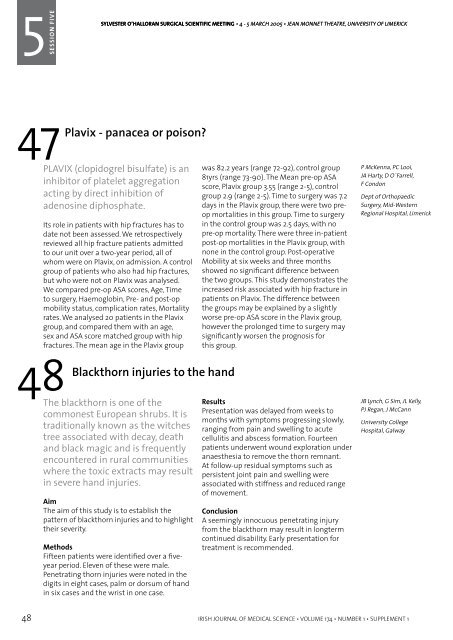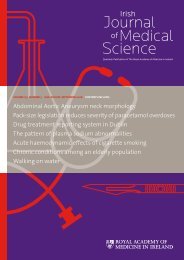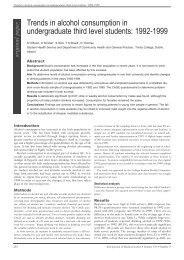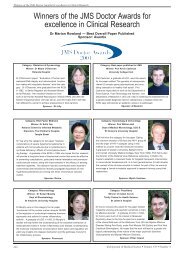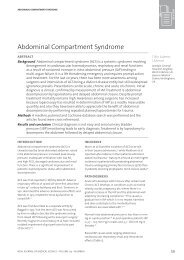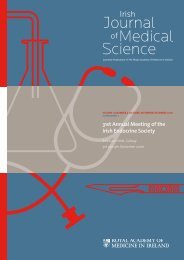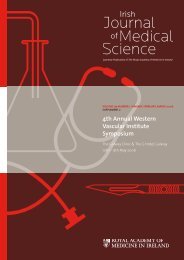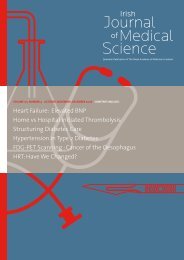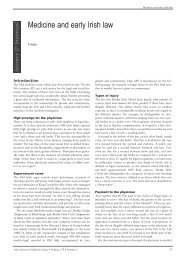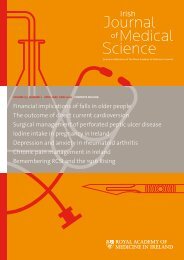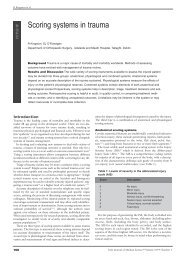Sylvester O'Halloran Surgical Scientific Meeting - IJMS | Irish Journal ...
Sylvester O'Halloran Surgical Scientific Meeting - IJMS | Irish Journal ...
Sylvester O'Halloran Surgical Scientific Meeting - IJMS | Irish Journal ...
Create successful ePaper yourself
Turn your PDF publications into a flip-book with our unique Google optimized e-Paper software.
51<br />
1<br />
SESSION FIVE ONE<br />
SYLVESTER O’HALLORAN SURGICAL SCIENTIFIC MEETING • 4 - 5 MARCH 2005 • JEAN MONNET THEATRE, UNIVERSITY OF LIMERICK<br />
SYLVESTER O’HALLORAN SURGICAL SCIENTIFIC MEETING • 4 - 5 MARCH 2005 • JEAN MONNET THEATRE, UNIVERSITY OF LIMERICK<br />
5<br />
SESSION<br />
SESSION FIVE ONE<br />
47 Plavix - panacea or poison P McKenna, PC Looi,<br />
PLAVIX (clopidogrel bisulfate) is an<br />
inhibitor of platelet aggregation<br />
acting by direct inhibition of<br />
adenosine diphosphate.<br />
Its role in patients with hip fractures has to<br />
date not been assessed. We retrospectively<br />
reviewed all hip fracture patients admitted<br />
to our unit over a two-year period, all of<br />
whom were on Plavix, on admission. A control<br />
group of patients who also had hip fractures,<br />
but who were not on Plavix was analysed.<br />
We compared pre-op ASA scores, Age, Time<br />
to surgery, Haemoglobin, Pre- and post-op<br />
mobility status, complication rates, Mortality<br />
rates. We analysed 20 patients in the Plavix<br />
group, and compared them with an age,<br />
sex and ASA score matched group with hip<br />
fractures. The mean age in the Plavix group<br />
was 82.2 years (range 72-92), control group<br />
81yrs (range 73-90). The Mean pre-op ASA<br />
score, Plavix group 3.55 (range 2-5), control<br />
group 2.9 (range 2-5). Time to surgery was 7.2<br />
days in the Plavix group, there were two preop<br />
mortalities in this group. Time to surgery<br />
in the control group was 2.5 days, with no<br />
pre-op mortality. There were three in-patient<br />
post-op mortalities in the Plavix group, with<br />
none in the control group. Post-operative<br />
Mobility at six weeks and three months<br />
showed no significant difference between<br />
the two groups. This study demonstrates the<br />
increased risk associated with hip fracture in<br />
patients on Plavix. The difference between<br />
the groups may be explained by a slightly<br />
worse pre-op ASA score in the Plavix group,<br />
however the prolonged time to surgery may<br />
significantly worsen the prognosis for<br />
this group.<br />
JA Harty, D O`Farrell,<br />
F Condon<br />
Dept of Orthopaedic<br />
Surgery, Mid-Western<br />
Regional Hospital, Limerick<br />
49 Ring-fencing - bed protection for the patient NT O’Malley, JA Sproule,<br />
Given the high and fluctuating<br />
admission figures in Trauma<br />
Orthopaedics, with priority appropriately<br />
being given to the primary<br />
trauma patient, difficulty arise in<br />
admitting patients for secondary<br />
procedures due to bed shortages.<br />
A ring-fencing policy was initiated whereby<br />
only trauma patients could be admitted to the<br />
ward in an effort to overcome the previously<br />
high cancellation figures (155 in a 12-month<br />
period), and also to maximise efficiency in<br />
accepting referrals from other centres.<br />
Figures were retrospectively accumulated<br />
from admission office files where it was<br />
noted if the patients (a) cancelled themselves,<br />
or (b) were cancelled through lack of beds.<br />
The latter figures were correlated with<br />
prospective data collected on the ward when<br />
infringements of the “ring-fence” policy<br />
occurred, such as when a non-trauma patient<br />
was admitted to the ward.<br />
Overall, there was a 20% decrease in<br />
cancelled secondary trauma admissions<br />
to the ward once the ring-fencing policy<br />
was implemented, in direct comparison<br />
to the previous 12-month period. Of note<br />
the number of “breaks” in the ring-fence<br />
accounted for 30% of cancelled admissions.<br />
In summary, by implementing a bedprotection<br />
policy our unit has decreased<br />
the secondary trauma waiting list by 40%.<br />
This measure, in conjunction with a planned<br />
discharge policy and maximum utilisation of<br />
the day ward will help optimise the Trauma<br />
unit efficiency and throughout.<br />
P Nicholson, JJ Rice,<br />
JP McElwain<br />
Dept of Trauma &<br />
Orthopaedics AMNCH<br />
Tallaght Dublin<br />
48 Blackthorn injuries to the hand JB Lynch, G Sim, JL Kelly,<br />
The blackthorn is one of the<br />
commonest European shrubs. It is<br />
traditionally known as the witches<br />
tree associated with decay, death<br />
and black magic and is frequently<br />
encountered in rural communities<br />
where the toxic extracts may result<br />
in severe hand injuries.<br />
Aim<br />
The aim of this study is to establish the<br />
pattern of blackthorn injuries and to highlight<br />
their severity.<br />
Methods<br />
Fifteen patients were identified over a fiveyear<br />
period. Eleven of these were male.<br />
Penetrating thorn injuries were noted in the<br />
digits in eight cases, palm or dorsum of hand<br />
in six cases and the wrist in one case.<br />
Results<br />
Presentation was delayed from weeks to<br />
months with symptoms progressing slowly,<br />
ranging from pain and swelling to acute<br />
cellulitis and abscess formation. Fourteen<br />
patients underwent wound exploration under<br />
anaesthesia to remove the thorn remnant.<br />
At follow-up residual symptoms such as<br />
persistent joint pain and swelling were<br />
associated with stiffness and reduced range<br />
of movement.<br />
Conclusion<br />
A seemingly innocuous penetrating injury<br />
from the blackthorn may result in longterm<br />
continued disability. Early presentation for<br />
treatment is recommended.<br />
PJ Regan, J McCann<br />
University College<br />
Hospital, Galway<br />
48 IRISH JOURNAL OF MEDICAL SCIENCE • VOLUME 174 • NUMBER 1 • SUPPLEMENT 1<br />
50 Penalty points: are they working JS Butler, JP Burke,<br />
We conducted a retrospective<br />
study of all acute admissions to the<br />
National Spinal Injuries Centre (NSIC)<br />
over a six-year period (November 1st<br />
1998 to October 31st 2004, n=966)<br />
to analyse the trends in Road Traffic<br />
Accident (RTA) related spinal injuries<br />
following the introduction of a post<br />
penalty points system.<br />
RTA-related spinal injuries accounted for<br />
39.3% of cases admitted to the NSIC over<br />
these six years. 35.2 % of these had some<br />
degree of neurological injury. RTA-related<br />
spinal injuries are significantly more common<br />
in males, with males between the ages of 16<br />
and 24 accounting for 31% of all RTA-related<br />
spinal injury admissions compared with<br />
females of the same age group accounting<br />
for 9.7%. There was an initial reduction of<br />
48.4% in RTA associated NSIC admissions<br />
following the introduction of Penalty Points,<br />
this has not been sustained. The number of<br />
road deaths has decreased since 1997 from<br />
472 to 376 in 2002 however the number of<br />
deaths/1000 collisions has increased over this<br />
period, from 34.74/1000 collisions in 1997 to<br />
39.24/1000 in 2002. The majority of patients<br />
who sustained a spinal injury were drivers,<br />
on a routine journey and on a rural road. The<br />
highest proportion of accidents resulting<br />
in spinal injury occurred during weekends<br />
(64.3% from Fri-Sun) and from midnight to<br />
6am (29.3%).<br />
We conclude the initial reduction in RTArelated<br />
NSIC admissions has not been<br />
sustained and the number of deaths per<br />
thousand collisions continues to rise. Young<br />
male drivers are currently the greatest<br />
at-risk group.<br />
DG Healy, MM Stephens,<br />
F McManus, D McCormack,<br />
JM O’Byrne, AR Poynton<br />
The National Spinal<br />
Injuries Unit, Dept of<br />
Orthopaedic Surgery,<br />
Mater Misericordiae<br />
University Hospital, Dublin<br />
IRISH JOURNAL OF MEDICAL SCIENCE • VOLUME 174 • NUMBER 1 • SUPPLEMENT 1 49


